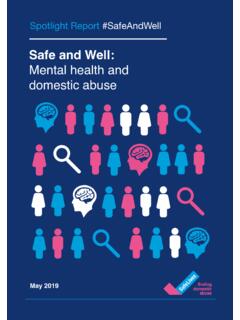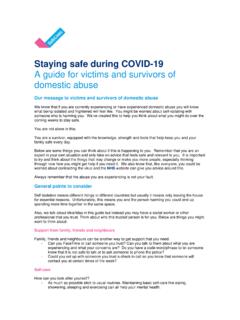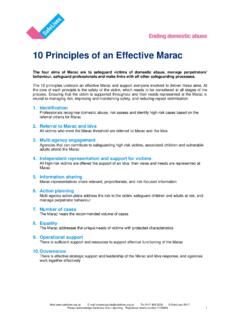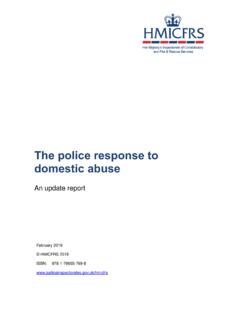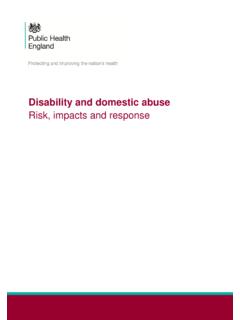Transcription of Safe Young Lives
1 Safe Young Lives : Young People and domestic abuse Contents About SafeLives 3. Executive Summary 6. Key Findings 10. Deinitions 12. Introduction 14. Policy context 15. Young victims of domestic abuse in intimate partner relationships 17. Young people who harm family members 24. The inluence of childhood experiences 26. The response to domestic abuse for Young people 28. Prevention and early intervention 38. Conclusion 41. Notes 43. Appendix: Insights data 46. 2. About SafeLives We are a national charity dedicated to Every year, nearly two million people ending domestic abuse , for good. We experience domestic abuse . For every combine insight from services, survivors person being abused, there is someone else and statistics to support people to become responsible for that abuse : the perpetrator. And safe, well and rebuild their Lives . Since 2005, all too often, children are in the home and living SafeLives has worked with organisations with the impact. across the country to transform the response to domestic abuse , with over domestic abuse affects us all; it thrives on 60,000 victims at highest risk of murder or being hidden behind closed doors.
2 We must serious harm now receiving co-ordinated make it everybody's business. support annually. No one should live in fear. It is not acceptable, not inevitable, and together we can make it stop. What would you want for your best friend? Early, consistent and tailored support that makes them safe and meets their needs. Help made available wherever they need it We want this for each and every whether from the police, their GP or hospital, person living with abuse . Wherever or where they live. they live, whoever they are. The choice to stay safely in their own home and community. The perpetrator challenged to change and held to account. A response that addresses the impact of domestic abuse on children and Young people. Agencies working together to meet the practical needs that people have, providing help on areas such as housing, money and access to justice. 3. What we do How we do it Place people with lived experience We are independent. at the heart of all we do and amplify their voices.
3 We focus on the practical: we believe in showing people what Test innovative projects and they can do, not telling them replicate effective approaches that they should do. make more people safe and well. We save time and money for Combine data, research and local areas by solving common frontline expertise to help services problems once and sharing the improve and to inluence policy solutions. makers (locally and nationally). We are informed by evidence of Offer support, knowledge and what really works. tools to frontline workers and professionals. We are informed by the lived experience and insight of survivors and amplify their voices in all we do. We learn from local provision and respect local circumstances, but show how national replication can be achieved. We work across organisational and sector boundaries. 4. About SafeLives' Insights service Insights is a whole family' outcomes measurement programme specifically designed for specialist domestic abuse services supporting adults and children who have experienced or are experiencing domestic abuse .
4 Insights enables services to understand who is accessing their service and identify gaps, to tailor interventions and support to meet the needs of their clients and to evidence the impact of their work on improving safety and wellbeing. Frontline practitioners collect information about the people they support and submit it to SafeLives via online forms. About this report This report will discuss Young people and domestic abuse . It is part of our Spotlight' series which focuses on hidden' groups of domestic abuse victims or those with unmet needs, and proposes recommendations for both practitioners and policy makers. We would like to thank all the practitioners, professionals and academics who participated in this Spotlight. Most of all, we would like to thank the Young people and parents who spoke so honestly and bravely about their experiences. Without your insight, this report would not be possible. Contact For queries about this report please contact 5. Executive Summary The third SafeLives Spotlight focuses on Young people aged 13 to 17 who experience domestic abuse in an intimate partner relationship, or.
5 Demonstrate harmful behaviours towards a family member. The numbers Young people experience the highest rates of domestic abuse of any age group. In March 2015, the Crime Survey for England and Wales identiied that of men and of women aged 16 to 19 had experienced domestic abuse in the past year. For women this is dramatically higher (42%) than the next highest category (ages 20 24), and for men it is almost one third higher (32%). 6 Safe Young Lives : Young People and domestic abuse abuse can begin even earlier than age 16 for large numbers of Young people. A survey of 13 to 17 year olds found that a quarter (25%). of girls and 18% of boys reported having experienced some form of physical violence from an intimate When I was 15 I got into a relationship that would change my life . One day I was on the phone to a male friend, and my partner decided that it wasn't okay for me to do that. That was the irst time he hit me. After that it kind of just becomes a blur.. Chantelle, Young survivor Our data shows that Young people, including those below 16, can experience all forms of domestic abuse2 and the likelihood of experiencing high severity abuse is no different to adults.
6 Indeed, the data suggests the levels of high severity abuse may be highest for the youngest age group. Since 2013, 16 and 17 year olds have been entitled to access adult domestic abuse support as a result of their inclusion in the cross-governmental deinition of domestic abuse . Despite the high prevalence of abuse for this age group, the rate of referrals into support services and multi-agency risk assessment conferences (Maracs) is lower than the percentage they make up of the population. Young people aged 16 and 17 represent of the adult (16+) population3 while of Marac referrals, 2% of referrals into Idva support and 1% of referrals into Outreach support are made for those aged 16 and 17 years old. For victims younger than 16, who must rely on limited specialist services for Young people, the visibility of victims is likely to be even lower. Additional Vulnerability Regardless of whether they can access adult support, the evidence suggests that Young people need a different response to adults.
7 Young people experience a complex transition from childhood to adulthood, which impacts on behaviour and decision making. It may impact on the way that they respond to the abuse as well as the way that they engage with services. Additionally, they may be unequipped to deal with the practical problems such as moving home or inances. As a result, Young people who experience domestic abuse do so at a particularly vulnerable point in their Lives . 7 Safe Young Lives : Young People and domestic abuse I wanted to move out from my mam's even though I was only 15 so I did, but my mam was not happy in the slightest. This was when stuff was starting to go different between us but I couldn't see it as I was madly in love with him.. Katie, Young survivor The abuse that Young people experience may also look different to the abuse that adults experience. Young people commonly experience abuse through new technologies and social media, which can be used as a monitoring or harassment tool by the perpetrator.
8 SafeLives data shows that Young people are more likely than adult victims of abuse to be in a relationship with the perpetrator at the point at which they accessed support. And our Spotlight case studies highlight that they may not see themselves as a victim', especially when they too are demonstrating some forms of abusive behaviour. Young people who demonstrate harmful behaviour For some Young people, the experience of domestic abuse includes causing harm to those closest to them, including partners, parents, siblings and other family members. Adolescent to parent violence can encompass a range of abusive behaviour as severe and complex as that seen in partner abuse cases, and is different to isolated incidents of violent or aggressive behaviour from a Young person. Our data shows that nearly a quarter (23%) of 13 to 17 year olds accessing specialist Young people's domestic abuse services are demonstrating harmful behaviour. SafeLives Insights data shows that 61% of Young people who were demonstrating harmful behaviour were doing so towards their mother.
9 When parents are the victim of abuse from a Young person, seeking help for their children and themselves is complex, and often the only options are through criminalising' the child's behaviour. We also know that the criminal justice response is often the only answer for Young people demonstrating abuse towards their partners. These Young people will often lack an understanding of healthy relationships, or need help to control behaviour that they know is wrong. Changing the attitude and response of these Young people is as important as holding them accountable for their behaviour. 8 Safe Young Lives : Young People and domestic abuse Understanding healthy relationships Research indicates that both Young men and women may not understand what constitutes a healthy relationship. The research project Boys to Men found that 49% of boys and 33% of girls aged 13 14 thought that hitting a partner would be okay' in at least one of twelve scenarios they were presented There is evidence5. that educational programmes can help change the attitudes of Young people towards domestic abuse and the recent announcement by government that Relationships and Sex Education will be made mandatory in schools is an important step.
10 I feel more conident to get into new relationships as I can use the work with the YPVA Service to see if the relationship I am in is healthy or unhealthy.. Billie-Jo, Young survivor This report draws on our evidence from the Safe Young Lives Spotlight, including SafeLives' own national dataset, to make recommendations about how we can increase the awareness and understanding of this issue, to provide better advocacy and support to help end domestic abuse for Young people. 9 Safe Young Lives : Young People and domestic abuse Key Findings In March 2015, the Crime Survey for England and Wales identiied that of men and of women aged 16 to 19 had experienced domestic abuse in the past year. For women this is dramatically higher (42%) than the next highest category (ages 20 24), and for men it is almost one third higher (32%). A study of 13 to 17 year olds by NSPCC suggests this abuse can begin even earlier in adolescence for large numbers of Young people. A quarter (25%) of girls and 18% of boys in the study reported having experienced some form of physical violence from an intimate partner.
